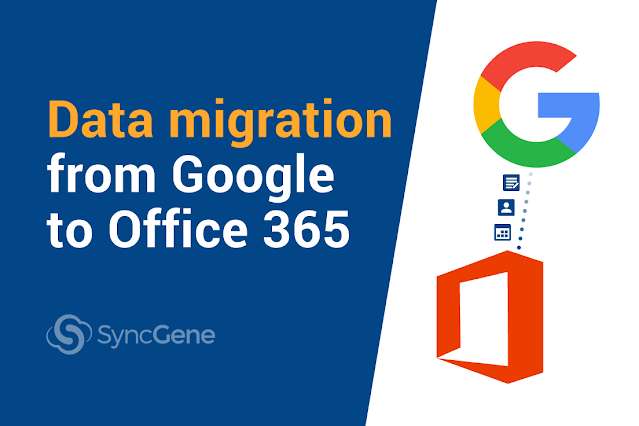
G Suite to Office 365 Migration
If you have ever planned it, you know that data migration is not as straightforward as it seems. Many enterprises today are unsure where to start with such a large project. And, if you are reading this article, you might need some help too.
If you have ever planned it, you know that data migration is not as straightforward as it seems. Many enterprises today are unsure where to start with such a large project. And, if you are reading this article, you might need some help too.
What is data migration? How do I move from G Suite to Office 365? How much planning should I do? What are the right tools for successful migration?
We will answer all your questions in this article. Ready? Let us dive into Google Workspace (formerly G Suite) to Office 365 migration, step-by-step.
Table of Contents:
- Defining data migration
- G Suite to Office 365 migration strategy
- Migration limitations in Google and Office 365
- SyncGene: the ultimate G Suite to Office 365 migration tool for Calendars and Contacts
- G Suite to Office 365 migration scenarios: cutover migration
- G Suite to Office 365 migration scenarios: coexistence
- How SyncGene Enterprise helps to migrate from G Suite to Office 365
- How to move from G Suite to Office 365?
Defining data migration
When we say data migration, we are talking about the process of extracting and permanently transferring data from one storage system to another. The process is not as clear as it seems, as the extracted data needs to go through a series of steps in preparation.
Let’s say your company is using Google Workspace / G Suite as your primary email service. You know that Office 365 has always been the primary choice for businesses. After all, in the corporate world, Microsoft’s mailing service was always the best option to maintain productivity. So, as your company grows, you consider migrating to Office 365.
Then you decide to undertake a Google Workspace / G Suite to Office 365 migration project. The goal of this process is to change the company’s workflow and boost performance.
When migrating emails, calendars, contacts, and tasks from Google Workspace / G Suite to Office 365 you need to plan a checklist, establish goals, and set a timeline. A clear strategy will help you foresee any challenges that you may encounter along the way.
G Suite to Office 365 migration strategy
Google Workspace / G Suite and Microsoft’s Office 365 are two platforms providing email, productivity tools and storage for businesses. Even though both services have lots in common, any IT administrator knows that there are substantial differences between the two platforms.
Options for Google Workspace / G Suite to Office 365 migration project are limited, so you should be prepared for different scenarios. The more elaborate your plan is, the less likely you are to encounter surprise costs or unplanned downtime. We recommend breaking the process into smaller steps:
- Identify the type of data you are migrating.
- Assess the process: how much time and resources you can invest to complete the project.
- Identify the required budget and tools.
- Choose the migration method: move data manually or get help from a high-quality data migration service.
- Before executing your plan, be sure to backup data to protect your files.
The right method for Google Workspace / G Suite to Office 365 migration is a crucial decision for a successful data transfer. You can execute the migration yourself, or you can seek help from a 3rd party to save you time and reduce the risk of errors.
We will review both options next in the article.
Migration limitations in Google and Office 365
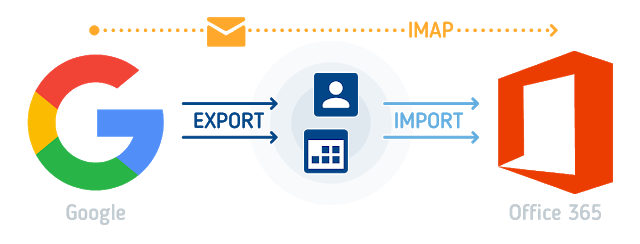
You can migrate from G Suite to Office 365 yourself. For manual migration, you will have to use the Internet Message Access Protocol (IMAP). However, IMAP migration has limitations. Let us look at them below.
- With IMAP migration, you can only move mailboxes. Contacts, calendars, or tasks will not be transferred.
- To migrate contact and calendars to Office 365, you will have to export the files from each account and import them to Office 365 manually.
- You can only migrate up to 500,000 items from a user mailbox to Office 365.
- The largest email that you can migrate is 35 MB.
Fortunately, there are easier solutions to move files from Google Workspace / G Suite to Office 365. We recommend using SyncGene to make migrations straightforward. Save time and ensure that no data from contacts or calendars is lost during the migration.
SyncGene: the ultimate G Suite to Office 365 migration tool for Calendars and Contacts
SyncGene can perform Calendars and Contacts transfer from G Suite to Office 365 for any number of mailboxes, saving you all the hassle of a complex migration. SyncGene holds a broad collection of tools and solutions to aid elaborate migrations from G Suite to Office 365.
SyncGene supports the most common migration methods: cutover and coexistence. Cutover strategies involve migrating all data in a few days, for example, over a weekend, ready for your users on Monday morning. Coexistence, or a long-term migration, allows companies to migrate data over a few weeks or months, while keeping both G Suite and Office 365 active.
Whether your business is acquiring another company or merging different mailing systems, data transfer from Google Workspace/G Suite to Office 365 will always be secure and fast with SyncGene.
G Suite to Office 365 migration scenarios: cutover migration

Cutover migration means moving data as a one-time switch of Calendars and Contacts from G Suite to Office 365. SyncGene can perform a single migration and move your entire organization to Office 365 over a couple of days.
This scenario suits businesses looking for a smooth data transition, leaving no gaps in productivity. As the set up can be done by an IT administrator via the SyncGene Enterprise panel, your employees will not even notice it.
SyncGene one-time migration solution:
- Provide employees with a SyncGene Enterprise account and set up sources.
- Give access to SyncGene Enterprise panel where IT admins set up synchronization.
- Sync Calendars and Contacts one-way from G Suite to Microsoft Office 365.
- Move old Calendars and Contacts to a new system automatically.
- Users can start using all the components of Office 365 immediately.
G Suite to Office 365 migration scenarios: coexistence
Your employees might want to keep Google and Office 365 accounts in parallel before fully switching to Microsoft. Coexistence provides flexible migration, without disrupting employees’ work.
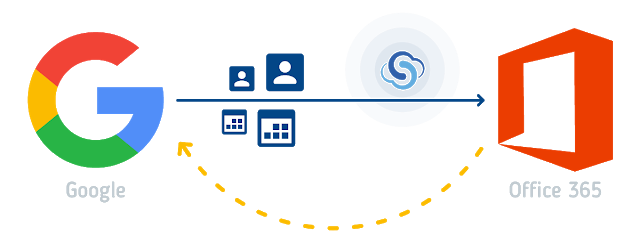
A staged migration lets migrating batches of data over a few weeks or months. This strategy is useful for enterprises holding large volumes of data.
SyncGene coexistence solution:
- Provide employees with a SyncGene Enterprise account and set up sources.
- Calendars and Contacts can be moved in stages.
- For emails – set up email forwarding rules, so that all incoming emails to Gmail would be automatically forwarded to Office 365 mailbox.
- Sync new Calendar and Contact entries one-way from G Suite to Microsoft Office 365.
- Employees can see their old Calendars and Contacts from Google in Office 365.
- Allows more time before the final cutover, avoiding tight deadlines.
A happy end-user is a sign of a successful migration. Satisfied customers are what SyncGene is proud of. Go ahead and check how SyncGene Enterprise solved G Suite to Office 365 migration cases for Enterprise clients:
How SyncGene Enterprise helps to migrate from G Suite to Office 365
SyncGene Enterprise offers a neat solution for the coexistence of G Suite and Office 365, as well as a smooth and fast cutover migration. Here are a few features that the service offers:
- Integrate contacts and calendars from Google with Office 365. Migrate calendars, contacts, tasks from Google Workspace to Office 365, or vice versa. All will work automatically and in the background, to avoid errors and save time.
- Nothing to install. The solution is easy to use. No installation is needed, all data syncs automatically in the cloud.
- Use the Admin Panel for centralized administration. Admins will manage member accessibility, control user data, and see synchronization status in real-time for each account.
- Add an unlimited number of users. Import an entire organization’s worth of accounts at once, with a few clicks.
- Customization and deployment. If you need a custom solution for your business, SyncGene can be flexible. We will adapt specific features to your requirements, in an optimal time frame. Discuss all customization solutions and plan deployment with your Dedicated Account Manager.
- Safety and security – guaranteed. Feel safe, SyncGene does not store synchronized data. It works as a tool to pass your information and keep it updated. SyncGene is hosted on Microsoft Azure – the most trusted and reliable cloud service in the world.
How to move from G Suite to Office 365?
Follow the steps below to learn how to migrate Calendars and Contacts from G Suite to Office 365 with SyncGene Enterprise.
Step 1: Get started. Head to the SyncGene site. Or, if you are on the go, SyncGene is also on mobile, with full-featured iOS and Android apps.
Click on Sign up to get a SyncGene account, or Log in, if you already have an account. Before starting the migration, be sure to have a valid SyncGene Enterprise subscription.
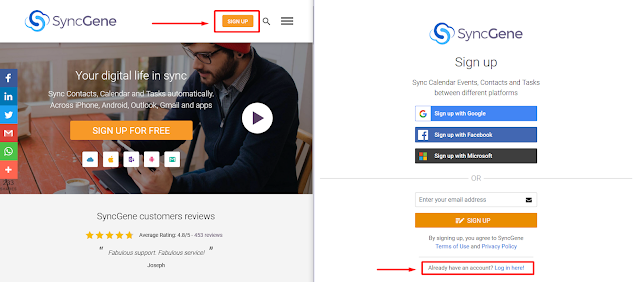
Step 2: Find the Enterprise panel. When your account is ready to go, the synchronization process is quite easy to set up. You will have to do it once and the service will take it from there. Go to the Enterprise Admin panel by clicking on SyncGene Teams, which are located under your account name.

Step 3: Set up member accounts and sources. For a smooth migration, you will want to add all company employees. For this, uploading a CSV file is the easiest solution. Before uploading the CSV file, make sure to set up sources for synchronization to each added account.
The CSV file can include the following columns:
- Login (A). This column will define how users will log in to their account.

- Sources (B, C). Here you will set up accounts for synchronization. Choose at least two sources.
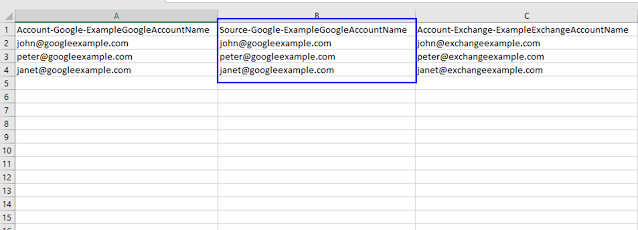
- Filter (D, optional). Choose which folder/group you want to synchronize between the sources. Choose default calendar and contacts folders, or all folders from all sources.

- Directions (E, F, optional). Set one-way or two-way synchronization.
See the in-depth step-by-step manual on how to prepare the CSV file and define values for each setting.
Step 4: Add users. Once you have the CSV file prepared, press on Members, then Add member to upload it.

You can also invite users to your Enterprise plan member-by-member. To do so, enter an email address into the field.
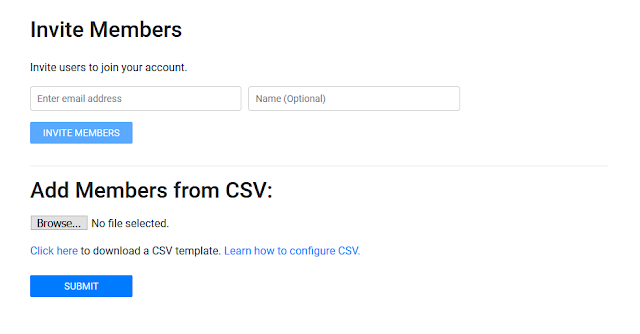
Step 5: Manage members. Via the Enterprise panel you will:
- Manage members. Change users’ names, set specific notification settings.
- Assign rights. Promote selected user to an admin or demote admin to a user. Admins can add/remove users, manage payments.
- Disable/Enable accounts. Accounts can be disabled or enabled. In case an account is disabled, he/she cannot log in and synchronize.
- Remove members. Remove the selected user from the enterprise account.
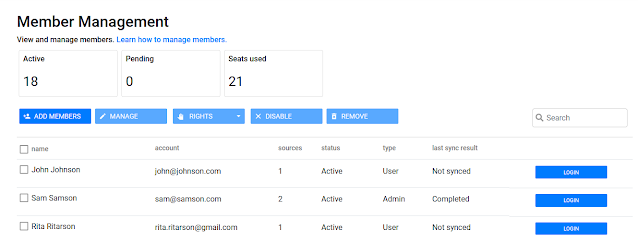
Step 6: Migrate from Google Workspace / G Suite to Office 365. When your preferences are set up, you are ready to go! Calendars and contacts will now be moved from G Suite to Office 365 for each added account. Fantastic job!
To sum up
There you go, that is everything you need to know about Google Workspace / G Suite to Office 365 migration. Now you know that with the right tools data transfer can be lemon squeezy! With SyncGene, migration will be a painless process for IT administrators, managers, and end-users.
Do not wait and check SyncGene Enterprise! And, if you have any questions, send us an email, give us a call, or start Live Chat.
Read more:








%20white.svg)
.svg)